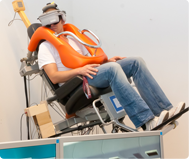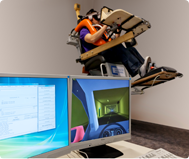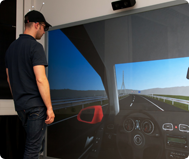Der Anspruch zu wissenschaftlich fundierten Entwicklungen zeigt sich auch an der regen Beteiligung an wissenschaftlichen Studien. Einzelne Studien werden im VR-Blog mit Bildern, Videos und weiteren Informationen vorgestellt.
Buchbeiträge und Überblicksartikel sind auf der Seite Überblicksliteratur gelistet.
wissenschaftliche Arbeiten (Einsatz virtueller Welten in der empirischen Forschung)
- Rodrigues, J., Ziebell, P., Müller, M., Hewig, A. (2022). Standardizing continuous data classifications in a virtual T-maze using two-layer feedforward networks. Sci Rep 12, 12879 (2022). doi: 10.1038/s41598-022-17013-5
- Kroczek LOH, Pfaller M, Lange B, Müller M. & Mühlberger A. (2020) Interpersonal Distance DuringReal-Time Social Interaction:Insights From Subjective Experience,Behavior, and Physiology. Frontiers in Psychiatry 11:561.doi: 10.3389/fpsyt.2020.00561
- Ronchi, E., Kinateder, M., Müller, M., Jost, M., Nehfischer, M. , Pauli, P. &. Mühlberger, A. (2015). Evacuation travel paths in virtual reality experiments for tunnel safety analysis. Fire Safety Journal 71 (0):257-267. doi
- Kinateder, M., Ronchi, E., Gromer, D., Müller, M., Jost, M., Nehfischer, M., Mühlberger, A., & Pauli, P. (2014). Social influence on route choice in a virtual reality tunnel fire. Transportation Research Part F: Traffic Psychology and Behaviour, 26, Part A(0), 116-125. doi
- Kinateder, M., Müller, M., Jost, M., Mühlberger, A. & Pauli, P. (2014). Social influence in a virtual tunnel fire – influence of conflicting information on evacuation behavior. Journal of Applied Ergonomics. doi
- Ewald, H., Glotzbach-Schoon, E., Gerdes. A.B.M., Andreatta, M., Müller, M., Mühlberger, A. & Pauli, P. (2014). Delay and trace fear conditioning in a complex virtual learning environment—neural substrates of extinction. Front. Hum. Neurosci. 8:323. doi
- Glotzbach-Schoon, E; Andreatta, M; Mühlberger, A; Pauli, P (2013). Context conditioning in virtual reality as a model for pathological anxiety.e-Neuroforum. 2013;4,3:63-70.
- Peperkorn HM, Mühlberger A. (2013). The impact of different perceptual cues on fear and presence in virtual reality. Studies in Health Technololgy and Informatics. 2013;191:75-9. PMID
- Glotzbach-Schoon, E., Tadda, R., Andreatta, M., Tröger, C., Ewald, H., Grillon, C., Pauli, P., Mühlberger, A. (2013). Enhanced Discrimination Between Threatening and Safe Contexts in High-Anxious Individuals. Biological Psychology.
- Kinateder, M., Pauli, P., Müller, M., Krieger, J., Heimbecher, F., Rönnau, I., Bergerhausen, U., Vollmann, G., Vogt, P., & Mühlberger, A. (2013). Human Behaviour in Severe Tunnel Accidents: Effects of Information and Behavioral Training. Transportation Research Part F: Traffic Psychology and Behaviour, 17, 20-32. doi
- Glotzbach, E., Ewald, H., Andreatta, M., Pauli, P., Mühlberger, A. (2012) Contextual fear conditioning predicts subsequent avoidance behavior in a virtual reality environment. Cognition and Emotion. 26, 1256-1272.
- Kinateder, M., Pauli, P., Müller, M., & Mühlberger, A. (2012). Stresserleben und verändertes Fahrverhalten nach einem virtuellen Autounfall. [Stress experience and changes in driving behaviour after a virtual driving accident]. Zeitschrift für Klinische Psychologie und Psychotherapie,41. 190-200. doi
- Tröger, C, Ewald, H., Glotzbach, E., Pauli, P., & Mühlberger, A. (2012). Does pre-exposure inhibit fear context conditioning? A Virtual Reality Study. Journal of Neural Transmission, 119, 709-719.
- Mühlberger, A., Neumann, R., Lozo, L., Müller, M. & Hettinger, M. (2012). Bottom-up and top-down influences of beliefs on emotional responses: Fear of heights in a virtual environment. In B.K. Wiederhold and G. Riva (Eds.), Annual Review of Cybertherapy and Telemedicine 2012 (pp 133-137). IOS Press. Amsterdam.
- Wieser, M.J., Pauli, P., Grosseibl, M., Molzow, I., & Mühlberger, A. (2010). Virtual Social Interaction in Social Anxiety – The Impact of Sex, Gaze and Interpersonal Distance. CyberPsychology, Behavior, and Social Networking. 13, 547-554.
- Mühlberger, A., Neumann, R., Wieser, M. J. & Pauli, P. (2008). The impact of changes in spatial distance on emotional responses. Emotion, 8, 192-198.
- Mühlberger, A., Wieser, M. J. and Pauli, P. (2008). Visual attention during virtual social situations depends on social anxiety. CyberPsychology & Behavior, 11, 425-430.
- Mühlberger, A., Wieser, M. J. and Pauli, P. (2008). The darkness-enhanced startle responses in ecological valid environments: A virtual tunnel driving experiment. Biological Psychology, 77, 47-52.
- Mühlberger, A., Bülthoff, H. H., Wiedemann, G. & Pauli, P. (2007). Virtual reality for psychophysiological assessment of phobic fear: responses during virtual tunnel drives. Psychological Assessment. 19. 340-346
wissenschaftliche Arbeiten zu Angsttherapie und Psychotherapie-Forschung mit virtuellen Welten
- Pfaller, Michael & Kroczek, Leon & Lange, Bastian & Fülöp, Raymund & Müller, Mathias & Mühlberger, Andreas. (2021). Social Presence as a Moderator of the Effect of Agent Behavior on Emotional Experience in Social Interactions in Virtual Reality. Frontiers in Virtual Reality. 2. doi: 10.3389/frvir.2021.741138.
- Diemer, J., Domschke, K., Mühlberger, A., Winter, B., Zavorotnyy, M., Notzon, S., Silling, K., Arolt, V. and Zwanzger, P. (2013). Acute anxiolytic effects of quetiapine during virtual reality exposure—A double-blind placebo-controlled trial in patients with specific phobia. European Neuropsychopharmacology, 23, 1551–1560. doi: 10.1016/j.euroneuro.2013.01.001
- Shiban, Y., Pauli, P., & Mühlberger, A. (2013). Effect of multiple context exposure on renewal in spider phobia. Behaviour Research and Therapy, 51, 68-74. DOI: 10.1016/j.brat.2012.10.007
- Mühlberger, A., Sperber, M., Wieser, M. J., Pauli, P. (2008). A virtual reality behavior avoidance test (VR-BAT) for the assessment of spider phobia. Journal of CyberTherapy & Rehabilitation 1,2.
- Mühlberger, A., Weik, A., Pauli, P. & Wiedemann, G. (2006). One-session virtual reality exposure treatment for fear of flying: one year follow-up and graduation flight accompaniment effects. Psychotherapy Research. 16, 26-40.
- Mühlberger, A., Petrusek, S., Herrmann, M. J. & Pauli, P. (2005). Biocyberpsychologie: Subjektive und physiologische Reaktionen von Flugphobikern und Gesunden bei Exposition mit virtuellen Flügen [Biocyber psychology: subjective and physiological reactions in flight phobics and normal subjects during flight simulations]. Zeitschrift für Klinische Psychologie und Psychotherapie. 34, 133-143.
- Mühlberger, A., Wiedemann, G. & Pauli, P. (2005). Subjective and physiologic reactions of flight phobics during VR exposure and treatment outcome: What adds motion simulation? Annual Review of CyberTherapy and Telemedicine: A decade of VR, 3, 185-192.
- Mühlberger, A., Wiedemann, G. and Pauli, P. (2003). Efficacy of a one-session virtual reality exposure treatment for fear of flying. Psychotherapy Research, 13(3), 323-336.
- Mühlberger, A., Herrmann, M. J., Wiedemann, G., Ellgring, H. & Pauli, P. (2001). Repeated exposure of flight phobics to flights in virtual reality. Behaviour Research and Therapy, 39, 1033-1050.
Konferenzbeiträge
- Koller, M., Schäfer, P., Sich, M., Diemer, J., Müller, M., & Meixner, G. (2018). Next Generation Virtual Reality Exposure Therapy Systems : a Study exploring Design Implications. Gehalten auf der 9th International Conference on Intelligent Systems 2018. urn=urn:nbn:se:kth:diva-244032
- Söhnchen, Bastian; Müller, Mathias & Pauli, Paul (2017). Advances in the research of anxiety and anxiety disorders using virtual reality. Insights from Eye Movement Research with Immersive Technologies, 19th European Conference on Eye Movements. 2017; 40.
- Mühlberger, Andreas; Kinateder, Max; Brütting, Johanna; Eder, Silke; Müller, Mathias; Pauli, Paul (2013). Influence of Information, Instructions on Human Behavior in Tunnel Accidents: A Virtual Reality Study.Virtuelle und Erweiterte Realität, 10. Workshop der GI-Fachgruppe VR/AR. 2013;49-60
- Kinateder, M., Müller, M., Mühlberger, A., & Pauli, P. (2012). Social Influence in a Virtual Tunnel Fire – Influence of Passive Virtual Bystanders. In 5th International Symposium on Human Behavior in Fire Symposium 2012 (pp. 506-516). London: Interscience Communications Ltd.
- Bärmann, S., Mühlberger, A., Müller, M., & Pauli, P. (2006). Einfluss visueller Tiefeninformation auf Gleichgewicht und Angsterleben bei Höhenängstlichen. In G. W. Alpers, H. Krebs, A. Mühlberger, P. Weyers & P. Pauli (Eds.), Wissenschaftliche Beiträge zum 24. Symposium der Fachgruppe Klinische Psychologie und Psychotherapie der DGPs (pp. 88). Würzburg: Pabst Science Publishers.
weitere…
- ausgewählte Publikationen von Anwendern von VT+Software und Systemen sind nach Forschungsgebiet kategorisiert gelistet unter CyberSession.Info -> Publikationen ›
- siehe auch Artikel bei Google Scholar zu CyberSession und VR ›




